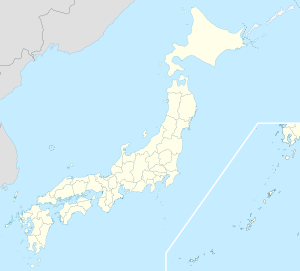Uwajima
| Uwajima-shi 宇 和 島 市 |
||
|---|---|---|
| Geographical location in Japan | ||
|
|
||
| Region : | Shikoku | |
| Prefecture : | Ehime | |
| Coordinates : | 33 ° 13 ' N , 132 ° 34' E | |
| Basic data | ||
| Surface: | 469.53 km² | |
| Residents : | 71,586 (October 1, 2019) |
|
| Population density : | 152 inhabitants per km² | |
| Community key : | 38203-5 | |
| Symbols | ||
| Flag / coat of arms: | ||
| town hall | ||
| Address : |
Uwajima City Hall 1 Akebono-chō Uwajima -shi Ehime 798-8601 |
|
| Website URL: | http://www.city.uwajima.ehime.jp/ | |
| Location Uwajimas in Ehime Prefecture | ||
Uwajima ( Japanese 宇 和 島 市 , - shi ) is a city in Ehime Prefecture , on Shikoku Island , Japan . It is located south of the city of Matsuyama .
geography
Uwajima is located in on the west coast of Shikoku . The urban area extends with all municipalities to 469.48 km². The city itself is located on the Suka River, which flows directly into Uwajima Bay. This is also the end point of the Matsuyama railway line.
history
In 1595 , Uwajima was still known as the village of Itajima when Tōdō Takatora became feudal lord over the Uwa region. He ordered the reconstruction of the then ruined Marugushi Castle.
After Date Masamune's death , his eldest son Date Hidemune took over the Uwa area and developed the castle into an economic and cultural center. In 1871 Uwa became a prefecture. In 1873 it was united with Ichizuchi Prefecture and the current Ehime Prefecture was created with the capital Matsuyama .
In 1889 Uwajima became a city. In the following years the villages of Maruho, Yahata and later Kushima were incorporated. During this time, the port area was also expanded, which is one of the most important economic sectors in the city today. During the war, Uwajima was badly damaged by American bombing raids in 1945 . After the war, the city was rebuilt so that today you can no longer see any traces of the war.
Attractions
Taga shrine
Taga Shrine, on the north bank of the Suka River, is arguably one of the most unusual shrines in Japan. It is one of the two remaining shrines dedicated to sexuality. Here you can find a variety of large, realistic phalluses made of wood and stone. There is also a sex museum on the grounds of the shrine, which exhibits images and artifacts related to the topic on two floors.
Uwatsuhiko Temple
One of Shikoku's oldest temples is the Uwatsuhiko Temple, which is located in the western part of the city. Its history goes back to the 7th century.
Uwajima Castle
The Castle of Uwajima is located on a hill in the center of the city. The area of the castle is designed as a spacious park. The main entrances to the park are Noboritchi Gate and the Koori Family Samurai Gate. From the castle you have a beautiful view over the city and the bay with the port of Uwajima.
Bullfights
The city is known for a form of bullfight ( 闘 牛 , tōgyū ) originating from the Ryūkyū Islands , which is comparable to the Swiss cow fight and does not require a matador. Two bulls compete against each other and fight until one of them hits the ground with his knees or falls out of the ring. The bullfights only take place on January 2nd, the second Sunday in April, July 24th and August 14th.
Town twinning
sons and daughters of the town
- Itō Daisuke (1898–1981), screenwriter and film director
- Kyōichi Katayama (* 1959), writer
- Haruhiro Yamashita (* 1938), apparatus gymnast
Neighboring cities and communities
Web links




